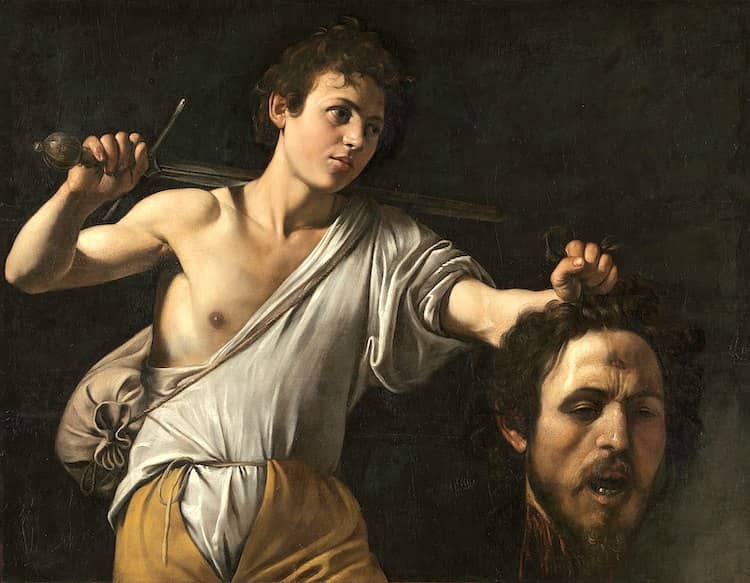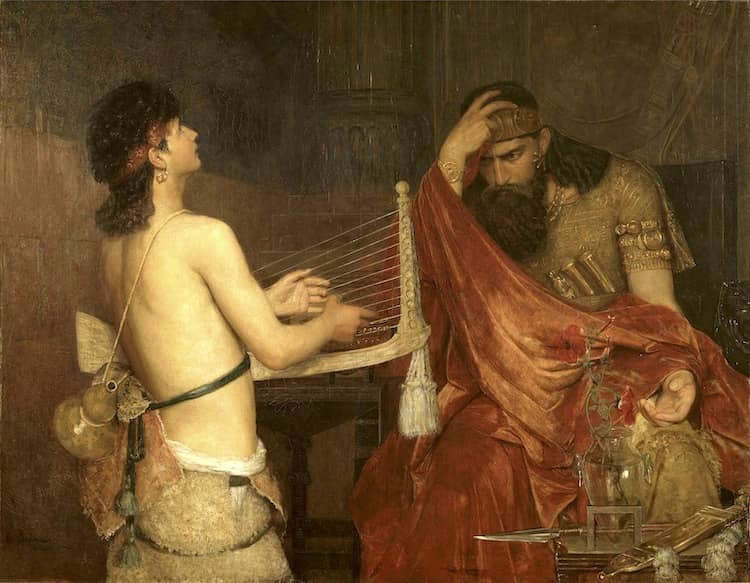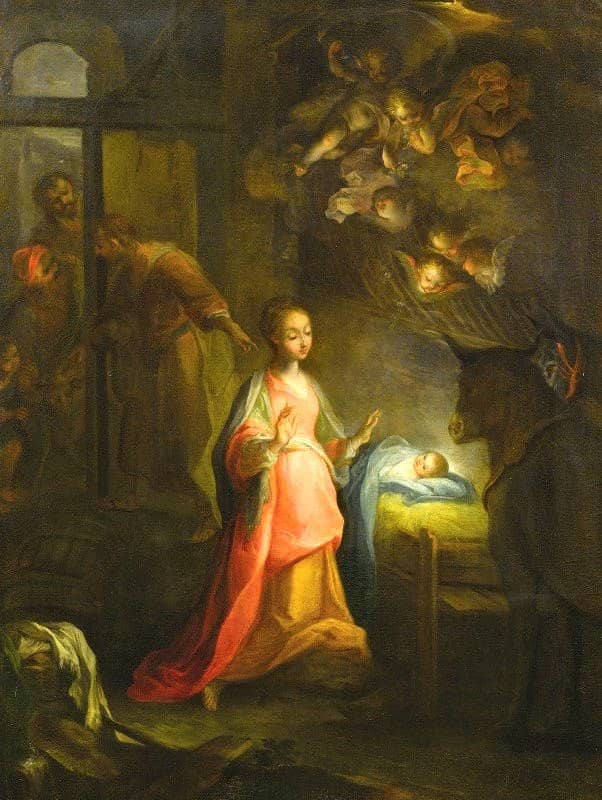Handel’s Operatic Style
For half his life, Handel put the best of his energies into composing operas in the formal Italian style. They are full of splendidly free and flowing melodies, some of which are still listened to today.
A few melodies are so well known that you may easily remember the operas in which they occur. In the prior lesson “Life of Handel,” we listened to the haunting aria ‘Lascia ch’io pianga’ from the opera Rinaldo.
Another lovely melody is ‘Ombra mai fu’ (‘Never was there a shadow’) which is more often known as Handel’s Largo and played just with instruments. It comes from the opera Xerxes, one of his later works written after he had already begun to rely more on his oratorios as a means of reaching success.
Listen to ‘Ombra mai fu’ (Never was there a shadow) from Xerxes HWV 40 (3 min)
The words are sung in Italian, but there are also English subtitles. Click on CC in the player, then select English. The instruments are, from left to right: two violins, a cello, a contrabass, and a lute. Notice how the lute provides gentle accompaniment to the mezzo-soprano’s lovely voice.
Though you are not likely to gain a much closer knowledge of Handel’s operas than a mere handful of the songs sung at concerts, they have a great importance in musical history which has been too often forgotten.
The long years of writing for the stage fixed Handel’s method as that of a dramatic composer. Whenever he approached a subject, whether it was that of an opera, an oratorio, or a cantata, it presented first to his mind a series of pictures such as the stage produces to the eye.
He saw before him the scene which the subject represented. He felt all the sensations which the events of the story would produce upon the minds of the characters in it. His aim was to make his music convey the scene, the events, and the feelings of the characters to his audience so that they might share them too.
His famous exclamation about the Hallelujah chorus, ‘I did think I did see Heaven opened and the great God himself’, shows that even the Messiah, which is less like his opera form than any one of the oratorios, was based to some extent upon a dramatic mental picture. In this case, the picture in his mind’s eye was the most sublime possible.
Many parts of the oratorios are simply operatic scenes upon Old Testament subjects. But the presence of a large chorus was a new factor which gradually led him away from the attitude of direct representation to something more reflective.
It will be easier to understand this if we look closely at one of his most famous oratorios, Saul.
Saul
After the opening overture (an overture is an instrumental piece that opens a larger work), the oratorio begins with a massive chorus. They sing ‘How excellent is Thy name’ and represent the Jewish people praising God for David’s victory over Goliath.

To achieve a heroic feel, Handel used a particularly large orchestra in which trombones, trumpets, and drums were added to the more usual instruments. His main object was to present a scene of national rejoicing.
Next, a short soprano air exults in the prowess of David, and then ‘the monster atheist’ is described in a short trio, the orchestral music of which suggests his big and lumbering form by repeating a heavy unison phrase.
Another chorus tells in a bold theme how the courage of the Israelites was restored by the sight of Goliath overthrown, and how they ‘headlong drove that impious crew’, and then the chorus bursts into a repetition of the first hymn of praise and ends the scene with a ringing chorus of Hallelujahs.
Listen to ‘Hallelujah’ from Saul (2 min)
The scene is dramatic, but it is not operatic, for it contemplates the story of David and Goliath. It does not try to give a direct representation of it. The following scenes of the oratorio are carried on in a strictly operatic way. All the principal characters make their appearance in turn.
First comes Michal, the daughter of Saul, who loves David and sings a song in his praise. Then Abner, the captain of the host, presents David to Saul who promises him the hand of his elder daughter Merab in marriage. Merab, however, despises him, and sings a very vigorous song to describe her emotions; finally comes Jonathan, who greets David with friendship in music of a calmer kind than that given to most of the characters.
Then a chorus of maidens, accompanied by a carillon (that is, a peal of bells played from a keyboard), enters with the song ‘Saul has slain his thousands and David his ten thousands’, which rouses Saul’s bitter jealousy.
Listen to ‘Welcome, Mighty King’ from Saul (1 min)
The well-known story of the evil spirit taking possession of Saul, of David’s playing before him, and his attempt to kill David is told with characteristic songs and recitatives, and there is a harp solo to represent David’s performance; it is just as though the characters were enacting the whole before our eyes upon a stage.
So much is this the case that Handel never troubles to tell his audience that Saul threw a javelin at David. He merely makes Saul sing an aria of burning hate and rage, and a rapid scale of demi-semi-quavers on the strings is meant to indicate the flight of the javelin, as though the composer were so completely wrapped up in the picture before his eyes that he had forgotten that the audience would not see it acted as he did in imagination.
It is not until the very end of the first part that Handel seems to remember that after all his work is not an opera, for he then finishes off the part with a Chorus which is not actually a part of the story but rather a comment on it.
The events of the second part of Saul are much less stirring than those of the first. The temporary reconciliation between Saul and David, the marriage of David with Michal, Saul’s attempt to kill Jonathan, do not call out the same dramatic power or pictorial brilliancy which Handel bestowed on the first part.

The events, and still more the emotions underlying the events of the third part, however, seized upon Handel’s vivid imagination as forcibly as did those of the first part. Saul’s visit to the Witch of Endor is treated most graphically.
The witch’s invocation is made to sound strange and unearthly by the violins playing a figure which continually falls and rises again by large intervals, and the hollow tones of the bassoons carry on the same feeling into the solemn recitative in which the spirit of Samuel speaks to Saul.
A very short orchestral interlude joins this to the scene after the battle when the Amalekite comes to tell David of the death of Saul. In a short but powerful song David condemns him for slaying the Lord’s Anointed, and then follows the wonderful Dead March, which has become one of the most celebrated pieces in the whole range of music connected with the subject of death.
After this the course of the oratorio turns completely away from anything like dramatic action until the end, when David is hailed as king by the people.
Immediately after the Dead March comes the lament for Saul and Jonathan, the point which shows us most clearly the difference between true oratorio, i. e. musical comment upon a dramatic subject, and opera, which is the direct representation of a drama in music. Handel carries it on by means of the chorus alternating with the solo voice of David. It begins with a beautiful choral number, ‘Mourn Israel’
Listen to ‘Mourn, Israel’ from Saul (3 min)
Then the recitative ‘O let it not in Gath be heard’ is followed by arias, and a short chorus, ‘Eagles were not so swift as they’ made vivid by the rushing scales of the violins and the bass part moving continuously in rapid quavers.
More arias and a fine number, ‘O fatal day’ in which both the solo and the chorus take part, continue the lament and lead up to the most imposing chorus in the oratorio, ‘Gird on thy sword’ which makes an inspiring climax.
This examination of Saul has shown us that almost everywhere the use of the chorus tends to make the oratorio less directly theatrical in style. It is in the great reflective parts, especially in the lament and the finale, that the chorus is most powerful.
Handel realized this, and in the same year that he wrote Saul he also produced Israel in Egypt, which is made up of indirect reflection upon the dramatic situation by means of huge choral numbers.
If you’d like to watch the entire oratorio for Saul, it is available here.
Other Oratorios
The first part of Israel in Egypt deals with the plagues of Egypt. Both they and the passage of the Israelites through the Red Sea shows Handel’s power of writing vivid descriptive music more than any other work.
In ‘He Gave Them Hailstones’, notice how he builds tension with the strings rising toward a climax, then uses timpani to mimic the hailstones hitting the earth.
Listen to ‘He Gave Them Hailstones’ from Israel in Egypt (2 min)
The second part of the oratorio is the song of praise for the delivery out of Egypt.
It is on a much larger scale like the lament which is the culminating point of Saul, except it is a song of joy instead of sorrow. It does not tell a story, but instead dwells with a heroic style upon the great events just past. It provokes feelings of triumphant thankfulness.
This is really one of the best uses of oratorio, for although it cannot show actions as well as opera can, it can express the underlying thoughts and ideas far more thoroughly.
Listen to ‘The Lord Shall Reign for Ever and Ever’ from Israel in Egypt (4 min)
The mixture of the direct, operatic style with the reflective one of oratorio is found in almost all Handel’s works of the kind. You may distinguish the two very clearly in Samson, Judas Maccabaeus, Solomon, and Jephthah, all of which were later than Israel in Egypt.
In only one of the works which follow Israel did he abandon the operatic manner altogether, and that was in the only Christian oratorio he ever wrote: Messiah.
Messiah

In Messiah, Handel made no attempt to give a dramatic representation of the birth, life, and passion of the Saviour. Only in one instance—the scene of the angels appearing to the shepherds of Bethlehem— did he give a description of events.
Instead, he used both solo voices and chorus as a means of meditating upon the facts of the story. Consequently the recitative explanatory sections, which was his usual means of relating incidents or conversations between the principal characters, is reduced to a minimum.
It is partly because the subject is so much greater than the semi-barbaric stories which he usually set to music, and partly because it is so much more truly fitted to the method of oratorio, that The Messiah has been judged universally to be Handel’s greatest work.
We may find choruses in the other oratorios which are finer than ‘For unto us’ or ‘His yoke is easy’, and solos which surpass ‘Rejoice greatly’ or ‘Why do the heathen rage’, but no work is so consistent in aim as Messiah.
Handel’s own remark about the Hallelujah chorus shows that his strong dramatic sense guided his choice of a subject and directed his effects, but he had thrown off theatrical means of expression entirely, and he dwelt more upon the deeper meaning and the emotions aroused by the subject than upon its external features.
He later told a friend that, as he wrote the famous Hallelujah chorus, “I did think I did see all Heaven before me—and the great God himself…. Where I was in my body or out of my body as I wrote it I know not. God knows.”

